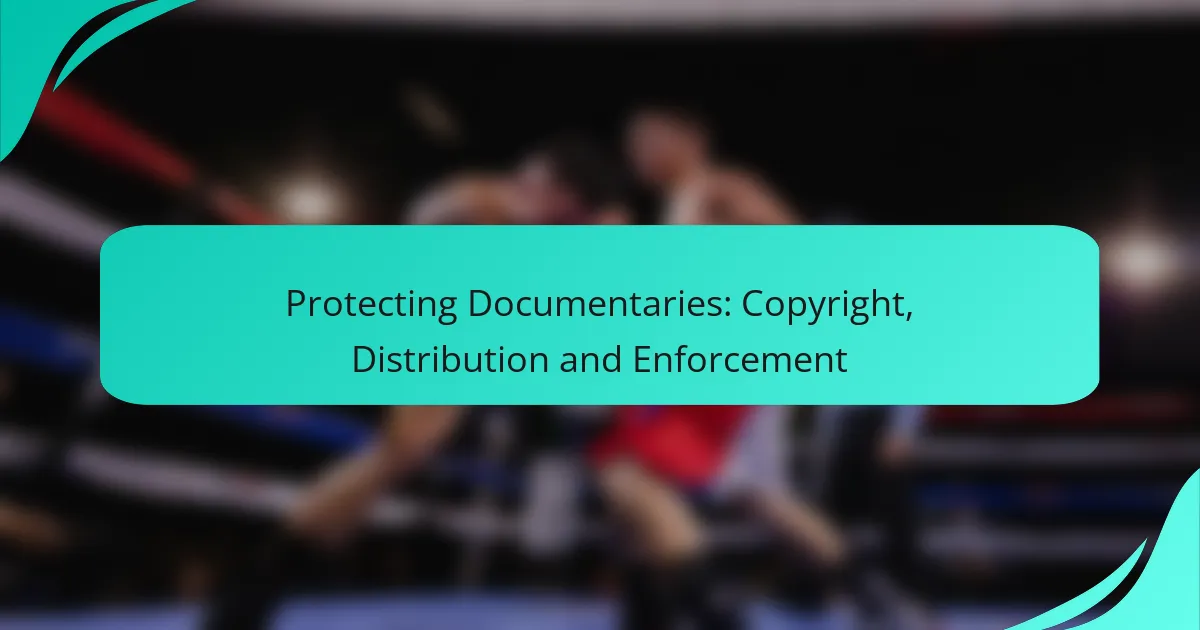Protecting documentaries through copyright law is essential for filmmakers, as it secures their original content and grants them exclusive rights to reproduce and distribute their work. Effective distribution strategies, including streaming services and film festivals, can enhance audience engagement while ensuring that creators maintain control over their projects. Additionally, filmmakers must actively monitor for unauthorized use and be prepared to enforce their rights to safeguard their creative endeavors.

How can documentaries be protected under copyright law?
Documentaries can be protected under copyright law by ensuring that the original content, including scripts, visuals, and sound, is registered and documented. This legal framework grants creators exclusive rights to reproduce, distribute, and display their work, safeguarding it from unauthorized use.
Copyright registration process
The copyright registration process involves submitting an application to the relevant authority, such as the U.S. Copyright Office, along with a copy of the documentary. Registration typically requires a fee and can take several months for processing. Once registered, the creator gains legal advantages, including the ability to sue for infringement and eligibility for statutory damages.
Fair use considerations
Fair use allows limited use of copyrighted material without permission, primarily for purposes like criticism, comment, news reporting, teaching, or research. When assessing fair use, courts consider factors such as the purpose of use, the nature of the original work, the amount used, and the effect on the market value. Documentaries often navigate fair use when incorporating archival footage or other protected content.
Licensing agreements
Licensing agreements are essential for documentaries that include third-party content, such as music or stock footage. These agreements outline the terms under which the content can be used, including duration, territory, and compensation. Clear licensing can prevent legal disputes and ensure that all parties are fairly compensated for their contributions.
International copyright treaties
International copyright treaties, such as the Berne Convention and the World Intellectual Property Organization (WIPO) treaties, provide a framework for protecting documentaries across borders. These agreements ensure that creators receive protection in member countries, facilitating the global distribution of their work. Understanding these treaties is crucial for filmmakers looking to distribute their documentaries internationally.
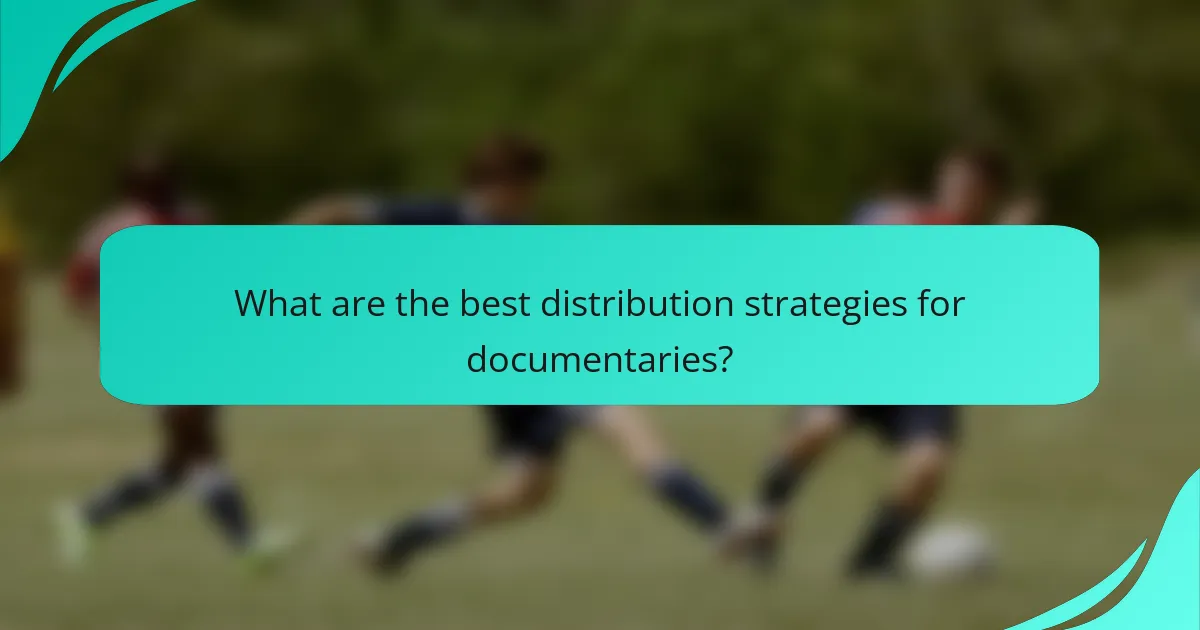
What are the best distribution strategies for documentaries?
The best distribution strategies for documentaries involve leveraging multiple platforms to maximize reach and audience engagement. Key options include streaming services, film festivals, broadcast television, and educational channels, each offering unique advantages and considerations.
Streaming platforms like Netflix
Streaming platforms such as Netflix provide a vast audience and the potential for significant viewership. Documentaries can gain traction through these services, especially if they align with current trends or social issues.
When distributing on streaming platforms, consider the platform’s submission guidelines and audience preferences. Engaging promotional materials and trailers can enhance visibility and attract viewers.
Film festivals and markets
Film festivals and markets are crucial for gaining recognition and networking within the industry. They offer opportunities for filmmakers to showcase their work to distributors, critics, and potential audiences.
Participating in well-known festivals can lead to awards and increased visibility. However, filmmakers should be aware of submission fees and deadlines, as well as the competitive nature of these events.
Broadcast television options
Broadcast television remains a viable option for documentary distribution, particularly for reaching older demographics. Networks often seek compelling stories that resonate with their viewers.
Filmmakers should research potential networks and their programming schedules to find the best fit for their documentary. Understanding the regulatory requirements for broadcast content is also essential.
Educational distribution channels
Educational distribution channels, including schools and universities, provide a unique avenue for documentaries focused on specific subjects. These channels can help reach students and educators who may benefit from the content.
To effectively distribute through educational channels, filmmakers should consider creating study guides or supplemental materials. Partnering with educational distributors can streamline the process and enhance outreach.
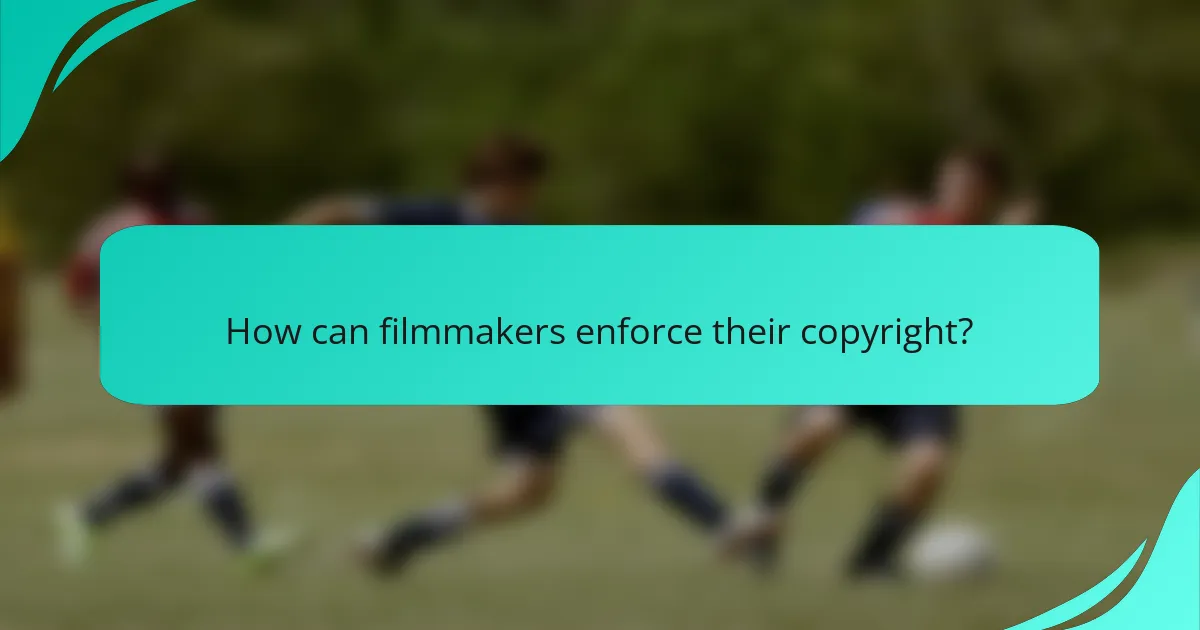
How can filmmakers enforce their copyright?
Filmmakers can enforce their copyright by actively monitoring for unauthorized use, sending cease and desist letters, and pursuing legal action if necessary. Understanding these steps helps protect their creative work from infringement and ensures they maintain control over distribution and profits.
Monitoring unauthorized use
Monitoring unauthorized use involves regularly checking various platforms, including social media, streaming services, and video-sharing sites, for any instances of copyright infringement. Filmmakers can use automated tools or services that scan for their content online, making it easier to identify unauthorized copies.
Establishing a routine for monitoring can help filmmakers catch infringements early, allowing for quicker responses. Keeping records of unauthorized uses is essential for any potential legal actions that may follow.
Cease and desist letters
Cease and desist letters are formal requests sent to individuals or entities that are infringing on a filmmaker’s copyright. These letters typically demand that the infringing party stop using the copyrighted material and may outline the potential legal consequences of continued infringement.
When drafting a cease and desist letter, it’s crucial to be clear and concise, stating the specific rights being violated and providing a deadline for compliance. This approach can often resolve issues without resorting to litigation, saving time and resources.
Legal action and litigation
If unauthorized use continues despite a cease and desist letter, filmmakers may need to consider legal action. This can involve filing a lawsuit for copyright infringement, which can be a lengthy and costly process. However, it may be necessary to protect their rights and seek damages.
Before pursuing litigation, filmmakers should weigh the potential costs against the benefits, including the likelihood of success and the impact on their reputation. Consulting with a legal professional experienced in copyright law can provide valuable guidance on the best course of action.
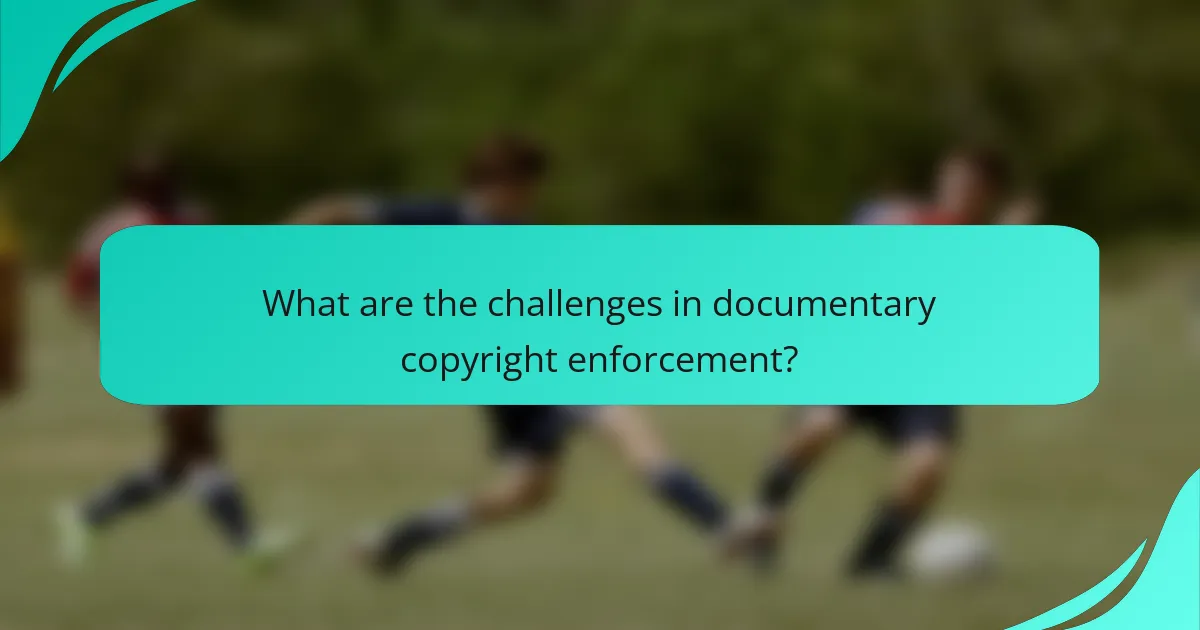
What are the challenges in documentary copyright enforcement?
Documentary copyright enforcement faces several significant challenges, including digital piracy, jurisdictional complexities, and resource limitations for small filmmakers. These hurdles can undermine the ability of creators to protect their work and monetize their efforts effectively.
Digital piracy issues
Digital piracy remains a major concern for documentary filmmakers, as unauthorized distribution can lead to significant revenue losses. Pirated content is often shared on various platforms, making it difficult for creators to track and enforce their rights. Implementing digital rights management (DRM) and watermarking can help deter piracy, but these measures are not foolproof.
To combat piracy, filmmakers should actively monitor online platforms for unauthorized copies of their work. Utilizing services that specialize in copyright enforcement can also be beneficial, although they may come with additional costs.
Jurisdictional complexities
Jurisdictional complexities arise because copyright laws vary significantly across countries. A documentary may be protected in one nation but not in another, complicating enforcement efforts. Filmmakers must navigate international copyright treaties, such as the Berne Convention, which can provide some level of protection but may not cover all scenarios.
Understanding the legal landscape in different regions is crucial. Filmmakers should consider seeking legal advice to ensure they are aware of the specific copyright laws applicable to their work in various jurisdictions.
Resource limitations for small filmmakers
Small filmmakers often face resource limitations that hinder their ability to enforce copyright effectively. Legal fees, administrative costs, and the time required to pursue infringement cases can be prohibitive for independent creators. As a result, many may choose to forgo legal action, leaving their work vulnerable.
To mitigate these challenges, small filmmakers can explore partnerships with organizations that support copyright enforcement or consider crowdfunding campaigns to raise funds for legal actions. Building a strong community around their work can also help amplify their voice against infringement.
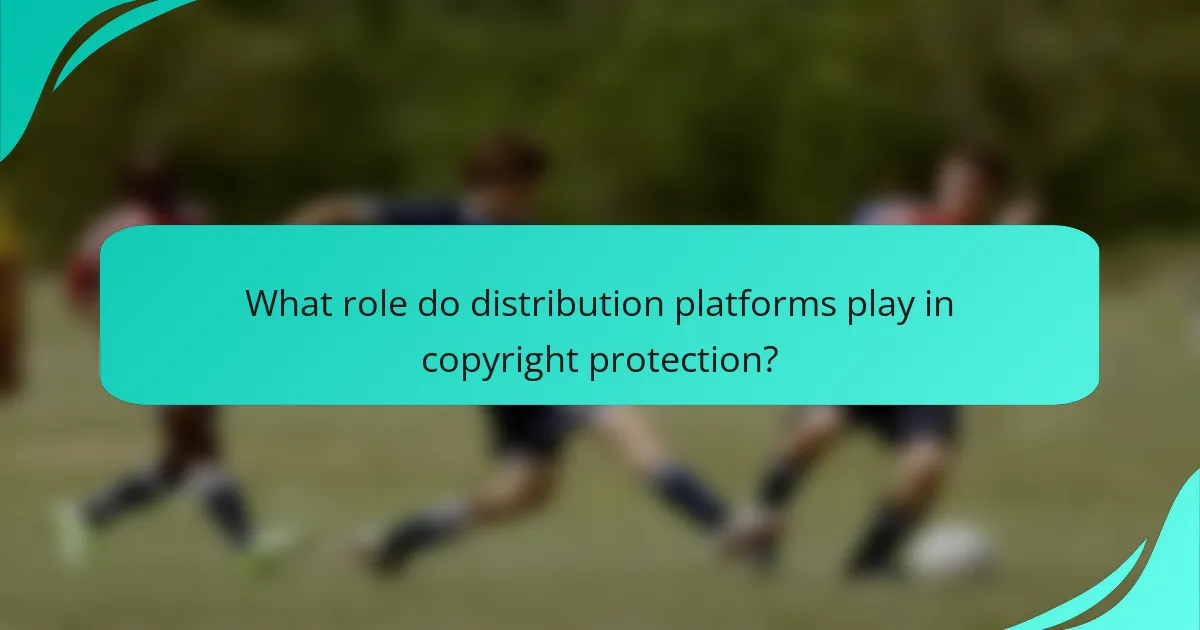
What role do distribution platforms play in copyright protection?
Distribution platforms are crucial in safeguarding the copyrights of documentaries by implementing measures that prevent unauthorized use and facilitate legal compliance. They provide a framework for content creators to manage their intellectual property while ensuring that users adhere to copyright laws.
Copyright enforcement mechanisms
Distribution platforms employ various copyright enforcement mechanisms to protect documentary content. These may include digital rights management (DRM) technologies, which restrict unauthorized copying and sharing, and content identification systems that detect and block infringing material. Platforms often collaborate with copyright holders to swiftly address violations.
Licensing agreements
Licensing agreements are essential for defining how documentaries can be distributed and used. These contracts outline the terms under which a documentary can be shared, including duration, territory, and payment structures. Creators should ensure that their agreements are clear and comprehensive to avoid potential disputes.
Revenue sharing models
Revenue sharing models on distribution platforms can impact a documentary’s financial success. Platforms may offer various arrangements, such as flat fees, royalties based on views, or a combination of both. Understanding these models helps creators choose the right platform that aligns with their financial goals.
Platform policies and compliance
Each distribution platform has its own policies regarding copyright compliance, which creators must understand and follow. Familiarizing oneself with these policies can prevent content removal or account suspension. Regularly reviewing platform guidelines ensures that documentary creators remain compliant and can effectively protect their work.
